Table Tennis for Three
Table Tennis for Three is a table tennis-like game with real paddles and balls that three players can play together although geographically apart. The players use an Exertion Interface to create a sense of social connectedness between each other, while communicating through an augmented videoconference. Table Tennis for Three aims to achieve similar benefits known from collocated table tennis such as exercise, enjoyment and bringing people together to socialize.
Leisure Games
Leisure activities, such as table tennis, are an important part of people’s lives. The benefits of leisure activities on mental and physical well-being have been widely discussed: from a mental health perspective, leisure is believed to have a beneficial effect on psychological well-being by promoting positive moods and it can help overcome loneliness. From a physical health perspective, athletic leisure activities contribute to a healthier body, reducing the risk of obesity, cardiovascular disease, diabetes, and more.
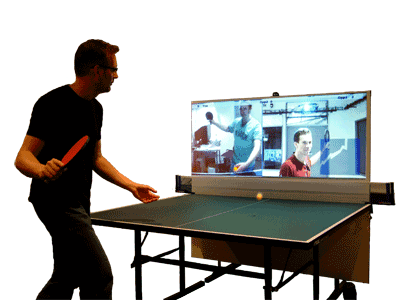
To provide an opportunity to maintain social connections with long-distant friends and relatives or create a sense of rapport between strangers, we have therefore incorporated mental and physical interactions similar to a table tennis game with telecommunication technology. In essence, we created a new experience that allows participants to enjoy an exerting leisure activity together although geographically apart: Table Tennis for Three!
Table Tennis for Three is based on table tennis, but can be played by players in three geographically distant locations. Although it has different rules than table tennis, the use of a table tennis table, a paddle and a ball inspired us to name it Table Tennis for Three. Just like table tennis, Table Tennis for Three is easy to learn and supports a sense of achievement quickly. It provides a health benefit by encouraging physical activity and training reflexes as well as hand-eye coordination. However, Table Tennis for Three is not aimed at replacing traditional table tennis, but rather can be a possible alternative if participants cannot be in the same location together.
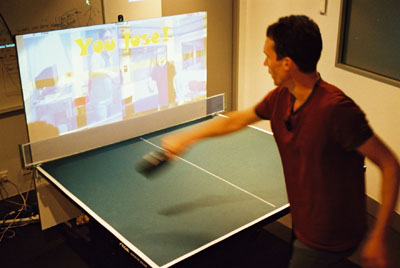
 GAMEPLAY
GAMEPLAY

Each player has a table tennis table, a paddle and a ball. The table is set up so that the ball can be hit against the vertically positioned opposite half of the table. This setup is familiar to table tennis players who practice on their own by playing the ball against the board. The vertical part of the table is painted white to also serve as projection surface for a videoconference of the other two players. Projected on top of the videoconference are eight semi-transparent targets that players have to hit with their ball. These targets, or blocks, “break” when hit by the players. The blocks are synchronized across the three tables, so the other players see the same block layout and the same block states. If a block is hit once, it cracks a little. If it is hit again (regardless of by which player), it cracks more. If hit three times, it breaks and disappears, revealing the underlying videoconferencing completely: the player broke through to the remote players. However, only the player who hits the block the third and final time makes it disappear and receives the point. This adds an element of strategy to the game: a player can try to snatch away points by hitting blocks that have already been hit twice by the other player. Each broken block scores one point, and once all blocks are cleared, the player with the most points wins the game.
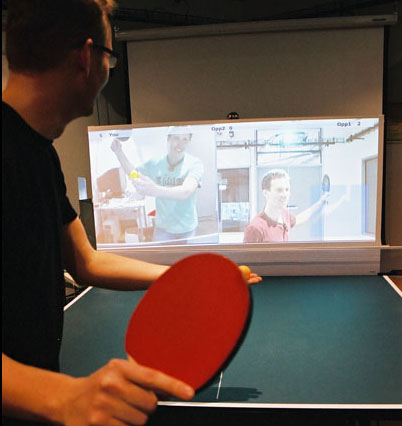
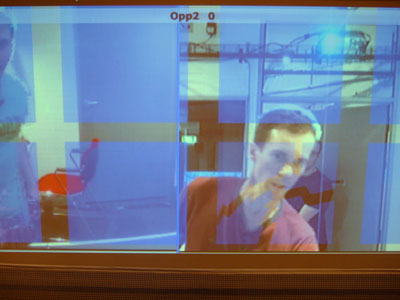
Technology
The backboards of the tables are instrumented so that the time and approximate location of a ball striking the table can be detected. Eight piezoelectric sensors are attached to the rear of the backboard in locations corresponding to the game-play blocks projected on the front of the backboard. The sensors detect the sound vibrations in the wooden board created by a ball striking it. The one sensor that receives the vibration signal first determines the location of the impact.
Conclusion
Table Tennis for Three combines the advantages of networked computer games (supporting multiple geographically distant players) with the advantages of traditional exerting leisure games (providing a social and health benefit). This concept scales to players in three locations. Players who played the game reported that they had fun and wanted to play again. Several players said that the game created a sense of social rapport, and that they were excited about being able to play together over a distance, which gave them “something to talk about”. This adds support to the claim that physical activity can be beneficial to social interaction.
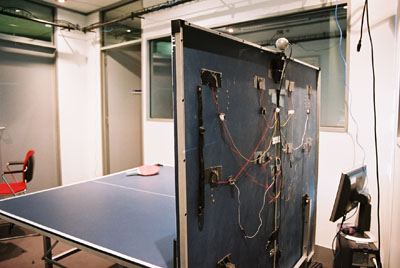
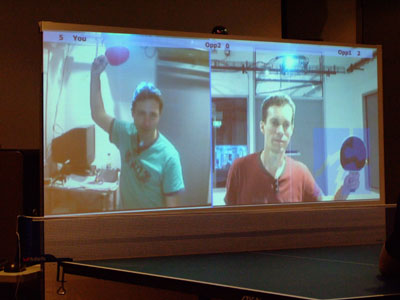
Acknowledgements
This project was initially supported by the University of Melbourne and CSIRO Collaborative Research Support Scheme and was executed by Florian 'Floyd' Mueller and Martin Gibbs. The analysis research was carried out by Florian 'Floyd' Mueller, Martin Gibbs and Frank Vetere in the Interaction Design Group at the University of Melbourne. We thank Shannon O'Brien, Matt Adcock, Bo Kampmann Walther, Keith Gibbs, Irma Lindt, the IDEAS Lab and the Interaction Design Group at the University of Melbourne and Ivo Widjaja. Thanks to Kerin Bryant for taking the still pictures.
Publications
Mueller, F., Gibbs, M. R. & Vetere, F. (2009) An Exploration of Exertion in Mixed Reality Systems via the “Table Tennis for Three” Game. In Dubois, E., Gray, P., Nigay, L. (Eds.) Engineering of Mixed Reality Systems. To appear 2009.
Mueller, F. & Berthouze, N. (2009) Evaluating Exertion Games - Experiences from Investigating Movement-Based Games. In Bernhaupt, R. (Ed.) Evaluating User Experiences in Games. To appear 2009.
![]() Wulf, V., Mueller, F., Moritz, S., Stevens, G. & Gibbs, M. (2009) Computer Supported Collaborative Sports: An Emerging Paradigm. In Digital Technology and Sport. http://www.igi-global.com/reference/details.asp?ID=33413&v=tableOfContents
Wulf, V., Mueller, F., Moritz, S., Stevens, G. & Gibbs, M. (2009) Computer Supported Collaborative Sports: An Emerging Paradigm. In Digital Technology and Sport. http://www.igi-global.com/reference/details.asp?ID=33413&v=tableOfContents
![]() Mueller, F. (2009) Exertion in Networked Games. Proceedings of the 4th International Conference on Foundations of Digital Games. Doctoral Consortium Extended Abstracts. Orlando, Florida. ACM, 346-348.
Mueller, F. (2009) Exertion in Networked Games. Proceedings of the 4th International Conference on Foundations of Digital Games. Doctoral Consortium Extended Abstracts. Orlando, Florida. ACM, 346-348.
![]() Mueller, F, Gibbs, M & Vetere, F (2009) Design Influence on Social Play in Distributed Exertion Games. CHI '09: Proceedings of the SIGCHI Conference on Human Factors in Computing Systems. Boston, MA, USA. ACM Press, New York, USA, 1539-1548.
Mueller, F, Gibbs, M & Vetere, F (2009) Design Influence on Social Play in Distributed Exertion Games. CHI '09: Proceedings of the SIGCHI Conference on Human Factors in Computing Systems. Boston, MA, USA. ACM Press, New York, USA, 1539-1548.
![]() Mueller, F., Gibbs, M., Vetere, F. & Agamanolis, S. (2008) Design space of networked exertion games demonstrated by a three-way physical game based on Table Tennis. ACM Computers in Entertainment, 6, 1-31.
Mueller, F., Gibbs, M., Vetere, F. & Agamanolis, S. (2008) Design space of networked exertion games demonstrated by a three-way physical game based on Table Tennis. ACM Computers in Entertainment, 6, 1-31.
![]() Mueller, F., & Gibbs, M. R. (2008). The Design of Networked Exertion Games. Journal of Virtual Reality and Broadcasting, 5, 13.
Mueller, F., & Gibbs, M. R. (2008). The Design of Networked Exertion Games. Journal of Virtual Reality and Broadcasting, 5, 13.
![]() Mueller, F. & Gibbs, M. (2007) Evaluating a distributed physical leisure game for three players. Conference of the computer-human interaction special interest group (CHISIG) of Australia on Computer-human interaction: OzCHI'07. Adelaide, Australia, ACM. (tier 2)
Mueller, F. & Gibbs, M. (2007) Evaluating a distributed physical leisure game for three players. Conference of the computer-human interaction special interest group (CHISIG) of Australia on Computer-human interaction: OzCHI'07. Adelaide, Australia, ACM. (tier 2)
![]() Mueller, F. & Gibbs, M. (2007) A physical three-way interactive game based on table tennis. Proceedings of the 4th Australasian Conference on Interactive Entertainment. Melbourne, Australia, RMIT University. (acceptance rate 50%, tier 2)
Mueller, F. & Gibbs, M. (2007) A physical three-way interactive game based on table tennis. Proceedings of the 4th Australasian Conference on Interactive Entertainment. Melbourne, Australia, RMIT University. (acceptance rate 50%, tier 2)
![]() Mueller, F., Vetere, F., Gibbs, M. (2007) Design Experiences with Networked Exertion Games. PerGames ’07-Pervasive Gaming Applications (acceptance rate 50%)
Mueller, F., Vetere, F., Gibbs, M. (2007) Design Experiences with Networked Exertion Games. PerGames ’07-Pervasive Gaming Applications (acceptance rate 50%)
Mueller, F., Gibbs, M. Table tennis over a distance. Demo, Australasian Conference on Interactive Entertainment, Australia. 2007. (tier 2)
![]() Mueller, F., Gibbs, M. (2007) Building a Table Tennis Game for Three Players. Short paper ACE ‘07-Advances in Computer Entertainment ACM SIGCHI (tier 1)
Mueller, F., Gibbs, M. (2007) Building a Table Tennis Game for Three Players. Short paper ACE ‘07-Advances in Computer Entertainment ACM SIGCHI (tier 1)
![]() Mueller, F. (2007) Evaluating a Networked Exertion Game. Workshop ACE’07
Mueller, F. (2007) Evaluating a Networked Exertion Game. Workshop ACE’07
![]() Mueller, F., Gibbs, M. (2007) Table Tennis for Three-the video. alt.chi CHI ‘07 (tier 1+)
Mueller, F., Gibbs, M. (2007) Table Tennis for Three-the video. alt.chi CHI ‘07 (tier 1+)
![]() Mueller, F., Gibbs, M. (2006) A Table Tennis Game for Three Players. OzCHI ‘06 (tier 2)
Mueller, F., Gibbs, M. (2006) A Table Tennis Game for Three Players. OzCHI ‘06 (tier 2)
Video
The video from above is also available to download (right-click, save as) in MPEG 2 format (DVD quality, 93 MB) and iPod format (MP4, 18 MB) and on YouTube.



 Table Tennis for Three
Table Tennis for Three


